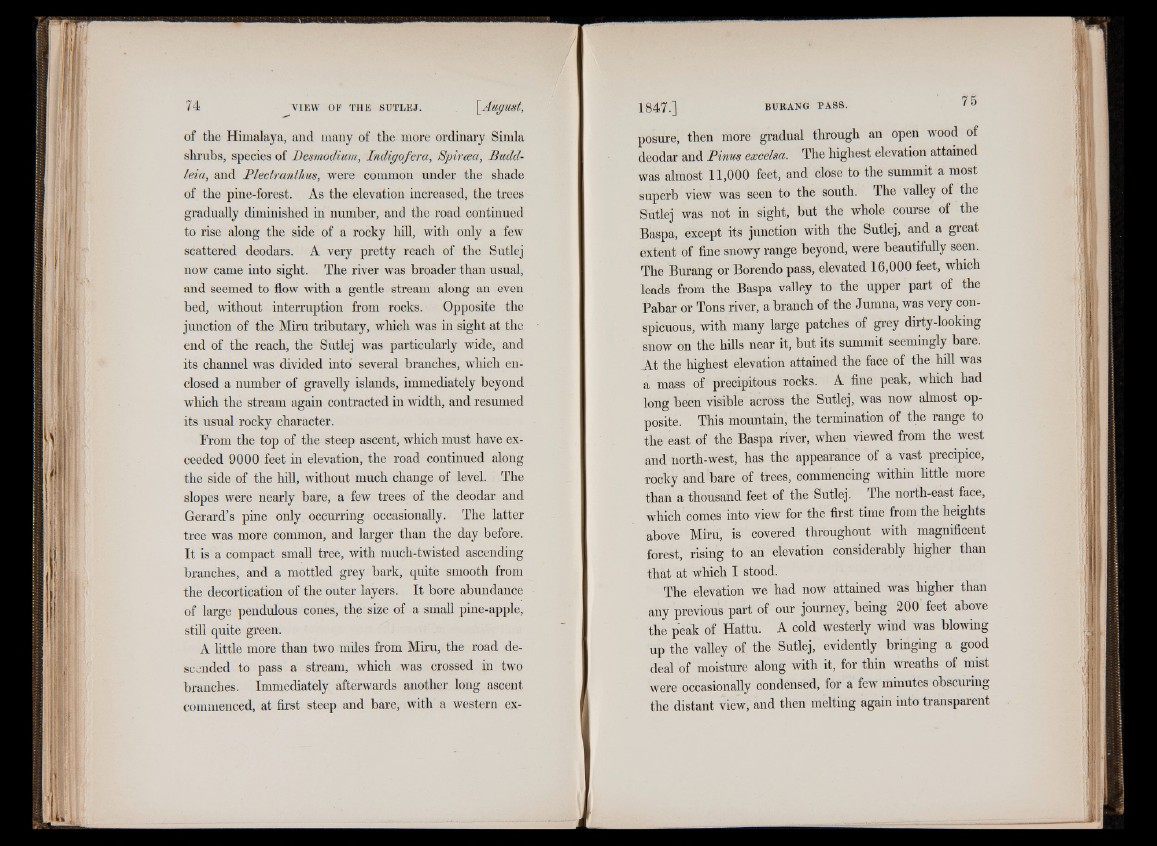
of the Himalaya, and many of the more ordinary Simla
shrubs, species of Desmodium, Indigofera, Spiraa, Budd-
leia, and Plectranthus, were common under the shade
of the pine-forest. As the elevation increased, the trees
gradually diminished in number, and the road continued
to rise along the side of a rocky hill, with only a few
scattered deodars. A very pretty reach of the Sutlej
now came into sight. The river was broader than usual,
and seemed to flow with a gentle stream along an even
bed, without interruption from rocks. Opposite the
junction of the Miru tributary, which was in sight at the
end of the reach, the Sutlej was particularly wide, and
its channel was divided into several branches, which enclosed
a number of gravelly islands, immediately beyond
which the stream again contracted in width, and resumed
its usual rocky character.
From the top of the steep ascent, which must have exceeded
9000 feet in elevation, the road continued along
the side of the hill, without much change of level. The
slopes were nearly bare, a few trees of the deodar and
Gerard’s pine only occurring occasionally. The latter
tree was more common, and larger than the day before.
It is a compact small tree, with much-twisted ascending
branches, and a mottled grey bark, quite smooth from
the decortication of the outer layers. It bore abundance
of large pendulous cones, the size of a small pine-apple,
still quite green.
A little more than two miles from Miru, the road descended
to pass a stream, which was crossed in two
branches. Immediately afterwards another long ascent
commenced, at first steep and bare, with a western exposure,
then more gradual through an open wood of
deodar and Pinus excelsa. The highest elevation attained
was almost 11,000 feet, and close to the summit a most
superb view was seen to the south. The valley of the
Sutlej was not in sight, but the whole course of the
Baspa, except its junction with the Sutlej, and a great
extent of fine snowy range beyond, were beautifully seen.
The Burang or Borendo pass, elevated 16,000 feet, which
leads from the Baspa valley to the upper part of the
Pabar or Tons river, a branch of the Jumna, was very conspicuous,
with many large patches of grey dirty-looking
snow on the hills near it, but its summit seemingly bare.
At the highest elevation attained the face of the hill was
a mass of precipitous rocks. A fine peak, which had
long been visible across the Sutlej, was now almost opposite.
This mountain, the termination of the range to
the east of the Baspa river, when viewed from the west
and north-west, has the appearance of a vast precipice,
rocky and bare of trees, commencing within little more
than a thousand feet of the Sutlej. The north-east face,
which comes into view for the first time from the heights
above Miru, is covered throughout with magnificent
forest, rising to an elevation considerably higher than
that at which I stood.
The elevation we had now attained was higher than
any previous part of our journey, being 200 feet above
the peak of Hattu. A cold westerly wind was blowing
up the valley of the Sutlej, evidently bringing a good
deal of moisture along with it, for thin wreaths of mist
were occasionally condensed, for a few minutes obscuring
the distant view, and then melting again into transparent